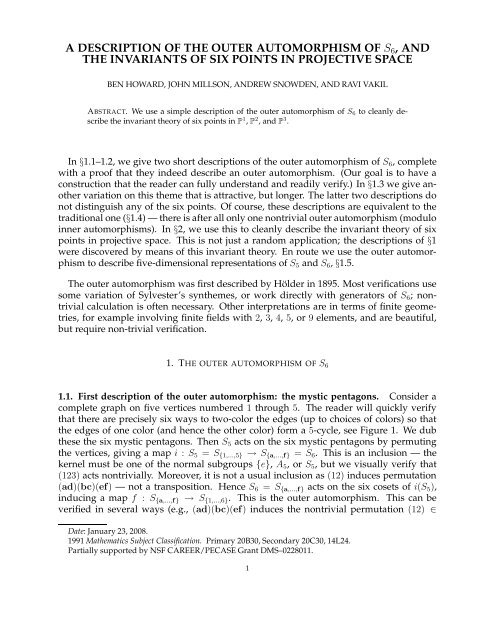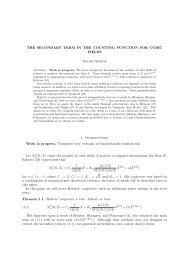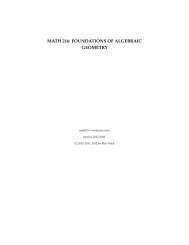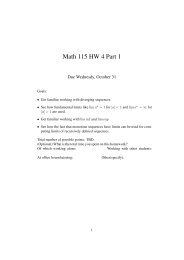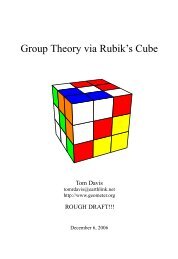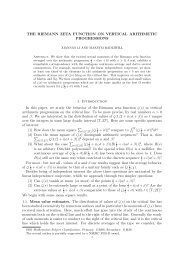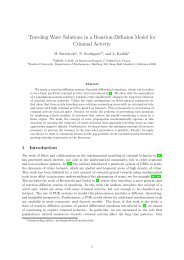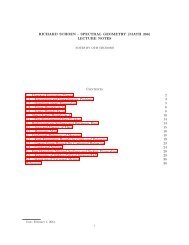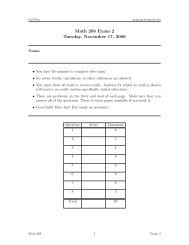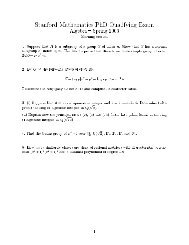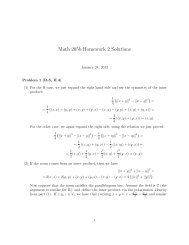a description of the outer automorphism of s6, and the invariants of ...
a description of the outer automorphism of s6, and the invariants of ...
a description of the outer automorphism of s6, and the invariants of ...
You also want an ePaper? Increase the reach of your titles
YUMPU automatically turns print PDFs into web optimized ePapers that Google loves.
A DESCRIPTION OF THE OUTER AUTOMORPHISM OF S 6 , AND<br />
THE INVARIANTS OF SIX POINTS IN PROJECTIVE SPACE<br />
BEN HOWARD, JOHN MILLSON, ANDREW SNOWDEN, AND RAVI VAKIL<br />
ABSTRACT. We use a simple <strong>description</strong> <strong>of</strong> <strong>the</strong> <strong>outer</strong> <strong>automorphism</strong> <strong>of</strong> S 6 to cleanly describe<br />
<strong>the</strong> invariant <strong>the</strong>ory <strong>of</strong> six points in P 1 , P 2 , <strong>and</strong> P 3 .<br />
In §1.1–1.2, we give two short <strong>description</strong>s <strong>of</strong> <strong>the</strong> <strong>outer</strong> <strong>automorphism</strong> <strong>of</strong> S 6 , complete<br />
with a pro<strong>of</strong> that <strong>the</strong>y indeed describe an <strong>outer</strong> <strong>automorphism</strong>. (Our goal is to have a<br />
construction that <strong>the</strong> reader can fully underst<strong>and</strong> <strong>and</strong> readily verify.) In §1.3 we give ano<strong>the</strong>r<br />
variation on this <strong>the</strong>me that is attractive, but longer. The latter two <strong>description</strong>s do<br />
not distinguish any <strong>of</strong> <strong>the</strong> six points. Of course, <strong>the</strong>se <strong>description</strong>s are equivalent to <strong>the</strong><br />
traditional one (§1.4) — <strong>the</strong>re is after all only one nontrivial <strong>outer</strong> <strong>automorphism</strong> (modulo<br />
inner <strong>automorphism</strong>s). In §2, we use this to cleanly describe <strong>the</strong> invariant <strong>the</strong>ory <strong>of</strong> six<br />
points in projective space. This is not just a r<strong>and</strong>om application; <strong>the</strong> <strong>description</strong>s <strong>of</strong> §1<br />
were discovered by means <strong>of</strong> this invariant <strong>the</strong>ory. En route we use <strong>the</strong> <strong>outer</strong> <strong>automorphism</strong><br />
to describe five-dimensional representations <strong>of</strong> S 5 <strong>and</strong> S 6 , §1.5.<br />
The <strong>outer</strong> <strong>automorphism</strong> was first described by Hölder in 1895. Most verifications use<br />
some variation <strong>of</strong> Sylvester’s syn<strong>the</strong>mes, or work directly with generators <strong>of</strong> S 6 ; nontrivial<br />
calculation is <strong>of</strong>ten necessary. O<strong>the</strong>r interpretations are in terms <strong>of</strong> finite geometries,<br />
for example involving finite fields with 2, 3, 4, 5, or 9 elements, <strong>and</strong> are beautiful,<br />
but require non-trivial verification.<br />
1. THE OUTER AUTOMORPHISM OF S 6<br />
1.1. First <strong>description</strong> <strong>of</strong> <strong>the</strong> <strong>outer</strong> <strong>automorphism</strong>: <strong>the</strong> mystic pentagons. Consider a<br />
complete graph on five vertices numbered 1 through 5. The reader will quickly verify<br />
that <strong>the</strong>re are precisely six ways to two-color <strong>the</strong> edges (up to choices <strong>of</strong> colors) so that<br />
<strong>the</strong> edges <strong>of</strong> one color (<strong>and</strong> hence <strong>the</strong> o<strong>the</strong>r color) form a 5-cycle, see Figure 1. We dub<br />
<strong>the</strong>se <strong>the</strong> six mystic pentagons. Then S 5 acts on <strong>the</strong> six mystic pentagons by permuting<br />
<strong>the</strong> vertices, giving a map i : S 5 = S {1,...,5} → S {a,...,f} = S 6 . This is an inclusion — <strong>the</strong><br />
kernel must be one <strong>of</strong> <strong>the</strong> normal subgroups {e}, A 5 , or S 5 , but we visually verify that<br />
(123) acts nontrivially. Moreover, it is not a usual inclusion as (12) induces permutation<br />
(ad)(bc)(ef) — not a transposition. Hence S 6 = S {a,...,f} acts on <strong>the</strong> six cosets <strong>of</strong> i(S 5 ),<br />
inducing a map f : S {a,...,f} → S {1,...,6} . This is <strong>the</strong> <strong>outer</strong> <strong>automorphism</strong>. This can be<br />
verified in several ways (e.g., (ad)(bc)(ef) induces <strong>the</strong> nontrivial permutation (12) ∈<br />
Date: January 23, 2008.<br />
1991 Ma<strong>the</strong>matics Subject Classification. Primary 20B30, Secondary 20C30, 14L24.<br />
Partially supported by NSF CAREER/PECASE Grant DMS–0228011.<br />
1
S {1,...,6} , so f is injective <strong>and</strong> hence an isomorphism; <strong>and</strong> i is not a usual inclusion, so f is<br />
not inner), but for <strong>the</strong> sake <strong>of</strong> simplicity we do so by way <strong>of</strong> a second <strong>description</strong>.<br />
1<br />
1<br />
1<br />
5<br />
2<br />
5<br />
2<br />
5<br />
2<br />
4<br />
3<br />
4<br />
3<br />
4<br />
3<br />
a<br />
b<br />
c<br />
1<br />
1<br />
1<br />
5<br />
2<br />
5<br />
2<br />
5<br />
2<br />
4<br />
3<br />
4<br />
3<br />
4<br />
3<br />
d<br />
e<br />
f<br />
FIGURE 1. The six mystic pentagons, with black <strong>and</strong> white (dashed) edges<br />
1.2. Second <strong>description</strong> <strong>of</strong> <strong>the</strong> <strong>outer</strong> <strong>automorphism</strong>: labeled triangles. We now make<br />
this construction more symmetric, not distinguishing <strong>the</strong> element 6 ∈ {1, . . . , 6}. Consider<br />
<strong>the</strong> ( 6<br />
3)<br />
= 20 triangles on six vertices labeled {1, . . . , 6}. There are six ways <strong>of</strong> dividing <strong>the</strong><br />
triangles into two sets <strong>of</strong> 10 so that (i) any two disjoint triangles have opposite colors, <strong>and</strong><br />
(ii) every tetrahedron has two triangles <strong>of</strong> each color. (The bijection between <strong>the</strong>se <strong>and</strong> <strong>the</strong><br />
mystic pentagons a, . . . , f is as follows. The triangle 6AB is colored <strong>the</strong> same as edge AB.<br />
The triangle CDE (6 ≠ C, D, E) is colored <strong>the</strong> opposite <strong>of</strong> <strong>the</strong> “complementary” edge AB,<br />
where {A, B} = {1, . . . , 5} − {C, D, E}.) The S 6 -action on this set is <strong>the</strong> <strong>outer</strong> <strong>automorphism</strong><br />
<strong>of</strong> S 6 . (Reason: (12) induces a nontrivial permutation (ad)(bc)(ef) <strong>of</strong> <strong>the</strong> mystic<br />
pentagons, so <strong>the</strong> induced map S 6 → S {a,...,f}<br />
∼ = S6 is injective <strong>and</strong> hence an isomorphism.<br />
But (12) does not induce a transposition on {a, . . . , f}, so <strong>the</strong> <strong>automorphism</strong> is not inner.)<br />
This isomorphism S {1,...,6} → S {a,...,f} is inverse to <strong>the</strong> isomorphism f <strong>of</strong> §1.1.<br />
1.3. Ano<strong>the</strong>r <strong>description</strong>: labeled icosahedra. Here is ano<strong>the</strong>r <strong>description</strong>, which<br />
is pleasantly S 6 -symmetric. Up to rotations <strong>and</strong> reflections, <strong>the</strong>re are twelve ways to<br />
number <strong>the</strong> vertices <strong>of</strong> an icosahedron 1 through 6, such that antipodal vertices have <strong>the</strong><br />
same label. Each icosahedron gives ten triples in {1, . . . , 6}, corresponding to <strong>the</strong> vertices<br />
around its faces. These twelve icosahedra come in six pairs, where two icosahedra are<br />
“opposite” if <strong>the</strong>y have no triples in common. (It is entertaining to note that if an icosahedron<br />
is embedded in Q(φ) 3 with vertices at (±1, ±φ, 0), (0, ±1, ±φ), <strong>and</strong> (±φ, 0, ±1), <strong>the</strong>n<br />
conjugation in Gal(Q(φ)/Q) sends <strong>the</strong> icosahedron to its opposite. Here φ is <strong>the</strong> golden<br />
section.) Then S 6 acts on <strong>the</strong>se six pairs, <strong>and</strong> this is <strong>the</strong> <strong>outer</strong> <strong>automorphism</strong>. One may<br />
show this via bijections to <strong>the</strong> <strong>description</strong>s <strong>of</strong> §1.1 <strong>and</strong> §1.2. Each pair <strong>of</strong> mystic icosahedra<br />
corresponds to two-coloring <strong>the</strong> triangles in {1, . . . , 6}, as in §1.2. For <strong>the</strong> bijection to §1.1,<br />
<strong>the</strong> cyclic order <strong>of</strong> <strong>the</strong> vertices around vertex 6 gives a mystic pentagon. (This provides a<br />
2
h<strong>and</strong>s-on way <strong>of</strong> underst<strong>and</strong>ing <strong>the</strong> S 6 -action on <strong>the</strong> mystic pentagons.) This <strong>description</strong><br />
is related to <strong>the</strong> explanation <strong>of</strong> <strong>the</strong> <strong>outer</strong> <strong>automorphism</strong> by John Baez in [B].<br />
1.4. Relation to <strong>the</strong> usual <strong>description</strong> <strong>of</strong> <strong>the</strong> <strong>outer</strong> <strong>automorphism</strong> <strong>of</strong> S 6 . The usual <strong>description</strong><br />
<strong>of</strong> <strong>the</strong> <strong>outer</strong> <strong>automorphism</strong> is as follows (e.g. [C]). A syn<strong>the</strong>me is a matching <strong>of</strong><br />
<strong>the</strong> numbers 1, . . . , 6, i.e. an unordered partition <strong>of</strong> {1, . . . , 6} into three sets <strong>of</strong> size two. A<br />
pentad is a set <strong>of</strong> five syn<strong>the</strong>mes whose whose union is <strong>the</strong> set <strong>of</strong> all 15 pairs. Then <strong>the</strong>re<br />
are precisely six pentads, <strong>and</strong> <strong>the</strong> action <strong>of</strong> S 6 on this set is via <strong>the</strong> <strong>outer</strong> <strong>automorphism</strong> <strong>of</strong><br />
S 6 . We explain how to get pentads from <strong>the</strong> mystic pentagons. Each mystic pentagon determines<br />
a bijection between <strong>the</strong> white edges <strong>and</strong> <strong>the</strong> black edges, where edge AB corresponds<br />
with edge CD if AB <strong>and</strong> CD don’t share a vertex. If E = {1, . . . , 5}−{A, B, C, D},<br />
<strong>the</strong>n to each such pair we obtain <strong>the</strong> syn<strong>the</strong>me AB/CD/E6, <strong>and</strong> <strong>the</strong>re are clearly five such<br />
syn<strong>the</strong>mes, no two <strong>of</strong> which share an edge, which hence form a pentad. For example,<br />
mystic pentagon a yields <strong>the</strong> pentad<br />
{12/35/56, 23/14/56, 34/25/16, 45/13/26, 15/24/36}.<br />
Ano<strong>the</strong>r common <strong>description</strong> <strong>of</strong> <strong>the</strong> <strong>outer</strong> <strong>automorphism</strong> relates directly to Figure 1. We<br />
find a subgroup G < S 5 <strong>of</strong> size 20; we take <strong>the</strong> subgroup preserving figure a <strong>of</strong> Figure 1.<br />
Then S 5 acts transitively on <strong>the</strong> six cosets <strong>of</strong> G, giving a map i : S 5 → S 6 . This map is<br />
an inclusion as (123) is not in its kernel. Then S 6 acts (transitively) on <strong>the</strong> six cosets <strong>of</strong><br />
i(S 5 ), yielding a map σ : S 6 → S 6 . The image (as it is transitive) has size > 2, hence (as S 6<br />
has only 3 normal subgroups) <strong>the</strong> kernel is e, hence σ is an <strong>automorphism</strong>. Then it is not<br />
inner, as i(S 5 ) is not one <strong>of</strong> <strong>the</strong> six “obvious” S 5 ’s in S 6 .<br />
1.5. Representations <strong>of</strong> S 5 <strong>and</strong> S 6 . In Figure 1, <strong>the</strong> edges are colored black <strong>and</strong> white<br />
so that each edge appears in each color precisely three times with this choice. This has<br />
<strong>the</strong> advantage that any odd permutation in S 5 (or S 6 ) permutes <strong>the</strong> six pentagons <strong>and</strong><br />
exchanges <strong>the</strong> colors.<br />
The pentagons give a convenient way <strong>of</strong> underst<strong>and</strong>ing <strong>the</strong> two 5-dimensional irreducible<br />
representations <strong>of</strong> S 5 . The permutation representation induced by this S 5 action<br />
on <strong>the</strong> mystic pentagons splits into an irreducible 5-dimensional representation F 5 <strong>and</strong> a<br />
trivial representation 1. The o<strong>the</strong>r irreducible 5-dimensional S 5 -representation F ′ 5 is obtained<br />
by tensoring F 5 with <strong>the</strong> sign representation ɛ, which can be interpreted as <strong>the</strong> S 5<br />
action on <strong>the</strong> mystic pentagons “with sign corresponding to color-swapping”.<br />
There are four irreducible 5-dimensional representation <strong>of</strong> S 6 . One is <strong>the</strong> st<strong>and</strong>ard representation<br />
(which we here denote B 5 ), obtained by subtracting <strong>the</strong> trivial representation<br />
1 from <strong>the</strong> usual permutation representation. A second is obtained by tensoring with <strong>the</strong><br />
sign representation ɛ: B ′ 5 := B 5 ⊗ ɛ. A third is analogous to <strong>the</strong> st<strong>and</strong>ard representation,<br />
obtained by subtracting <strong>the</strong> trivial representation 1 from <strong>the</strong> (<strong>outer</strong>) permutation representation<br />
<strong>of</strong> S 6 on <strong>the</strong> six mystic pentagons. One might denote this <strong>the</strong> <strong>outer</strong> <strong>automorphism</strong><br />
representation. The fourth 5-dimensional S 6 -representation is O ′ 5 := O 5 ⊗ ɛ. One might<br />
term this <strong>the</strong> signed <strong>outer</strong> <strong>automorphism</strong> representation. It is clear from <strong>the</strong> construction that<br />
F 5 <strong>and</strong> F ′ 5 are obtained by restriction from O 5 <strong>and</strong> O ′ 5 .<br />
3
1.6. An alternate <strong>description</strong> <strong>of</strong> <strong>the</strong>se representations is as follows. There are twelve 5-<br />
cycles on vertices labeled {1, . . . , 5}, which come in pairs <strong>of</strong> “opposites”, consisting <strong>of</strong><br />
disjoint 5-cycles. Each mystic pentagon is equivalent to such a pair. If x is a 5-cycle,<br />
denote its opposite by x. (The same construction applies for triangles on {1, . . . , 6}, §1.2,<br />
or labeled icosahedra, §1.3.) If we have twelve variables Z a , . . . , Z f , Z a , . . . , Z f<br />
, with <strong>the</strong><br />
conditions Z x = −Z x , <strong>the</strong> S 6 -action induces <strong>the</strong> representation O 5 ′ ⊕ ɛ. (Of course, <strong>the</strong><br />
o<strong>the</strong>r three representations can be described similarly, O 5 by imposing Z x = Z x instead<br />
<strong>and</strong> replacing ɛ by 1, F 5 ′ by considering <strong>the</strong> S 5 -action, <strong>and</strong> F 5 by making both changes.)<br />
2. THE INVARIANT THEORY OF SIX POINTS IN PROJECTIVE SPACE<br />
We will now relate <strong>the</strong> <strong>outer</strong> <strong>automorphism</strong> <strong>of</strong> S 6 to <strong>the</strong> space <strong>of</strong> six ordered points in<br />
projective space, or more precisely <strong>the</strong> geometric invariant <strong>the</strong>ory quotient (P n ) 6 //P GL(n+<br />
1). The algebraic statements in this section may be readily checked by any computer algebra<br />
program such as Maple, so <strong>the</strong> details are omitted. They were derived using explicit<br />
representation <strong>the</strong>ory <strong>of</strong> S 6 , <strong>and</strong> again <strong>the</strong> details are unenlightening <strong>and</strong> will be omitted.<br />
In some sense <strong>the</strong>se quotients generalize <strong>the</strong> notion <strong>of</strong> cross-ratio, <strong>the</strong> space <strong>of</strong> four<br />
points in P 1 . Any two generic sets <strong>of</strong> six ordered points in P n are projectively equivalent<br />
if n > 3, so <strong>the</strong> interesting cases are n = 1, 2, 3. All three cases were studied classically,<br />
<strong>and</strong> were known to behave beautifully.<br />
2.1. Six points on P 1 . The space <strong>of</strong> six points on P 1 may be interpreted as a threefold in<br />
P 5 cut out by <strong>the</strong> equations [DO, p. 17]<br />
Z 1 + · · · + Z 6 = Z 3 1 + · · · + Z3 6 = 0.<br />
(Aside: This is one <strong>of</strong> <strong>the</strong> many ways in which 6 points are special. If m ≠ 6, <strong>the</strong> space<br />
<strong>of</strong> m points in P 1 , (P 1 ) m //P GL(2), is cut out by quadrics [HMSV].) This is <strong>the</strong> Segre cubic<br />
relation, <strong>and</strong> this moduli space is known as <strong>the</strong> Segre cubic threefold, which we denote S 3 .<br />
There is an obvious S 6 -action on both (P 1 ) 6 <strong>and</strong> <strong>the</strong> variables Z 1 , . . . , Z 6 . One might hope<br />
that <strong>the</strong>se actions are conjugate, which would imply some bijection between <strong>the</strong> six points<br />
<strong>and</strong> <strong>the</strong> six variables. But remarkably, <strong>the</strong>y are related by <strong>the</strong> <strong>outer</strong> <strong>automorphism</strong> <strong>of</strong> S 6 .<br />
An alternate interpretation <strong>of</strong> this quotient is as <strong>the</strong> space <strong>of</strong> equilateral hexagons in<br />
real 3-space, with edges labeled 1 through 6 cyclically, up to translations <strong>and</strong> rotations<br />
[KM]. Rearranging <strong>the</strong> order <strong>of</strong> <strong>the</strong> edges induces a permutation <strong>of</strong> <strong>the</strong> Z-variables via<br />
<strong>the</strong> <strong>outer</strong> <strong>automorphism</strong>.<br />
Here is a clue that <strong>the</strong> <strong>outer</strong> <strong>automorphism</strong> is relevant. The cross-ratio <strong>of</strong> a certain four<br />
<strong>of</strong> <strong>the</strong> six points is given by [Z 1 ; . . . ; Z 6 ] ↦→ −(Z 1 +Z 2 )/(Z 3 +Z 4 ). A more symmetric avatar<br />
<strong>of</strong> <strong>the</strong> cross-ratio <strong>of</strong> four points on a line is given by<br />
(P 1 ) 4 <br />
P 2<br />
(p 1 , p 2 ,<br />
[(p p 3 , p 4 )<br />
2 − p 3 )(p 1 − p 4 ); (p 1 − p 2 )(p 3 − p 4 ); (p 1 − p 3 )(p 4 − p 2 )].<br />
4
(Here points <strong>of</strong> P 1 are written in projective coordinates for convenience; more correctly<br />
we should write [u i , v i ] for p i , where [u i , v i ] = [p i , 1].) Note that <strong>the</strong> S 4 -symmetry is clear in<br />
this manifestation. The image is <strong>the</strong> line X +Y +Z = 0 in P 2 . The traditional cross-ratio is<br />
−X/Y . In this symmetric manifestation, <strong>the</strong> cross-ratio <strong>of</strong> a certain four <strong>of</strong> <strong>the</strong> six points<br />
is given by [Z 1 ; . . . ; Z 6 ] ↦→ [Z 1 +Z 2 ; Z 3 +Z 4 ; Z 5 +Z 6 ]. The correspondence <strong>of</strong> a pair <strong>of</strong> points<br />
with a “syn<strong>the</strong>me” <strong>of</strong> <strong>the</strong> Z-variables is a hint that <strong>the</strong> <strong>outer</strong> <strong>automorphism</strong> is somehow<br />
present.<br />
We now describe <strong>the</strong> moduli map (P 1 ) S 3 explicitly. If <strong>the</strong> points are p 1 , . . . , p 6<br />
(1 ≤ i ≤ 6), <strong>the</strong> moduli map is given (in terms <strong>of</strong> <strong>the</strong> second <strong>description</strong> <strong>of</strong> <strong>the</strong> <strong>outer</strong><br />
<strong>automorphism</strong>, §1.2) by<br />
∑<br />
Z x =<br />
±p A p B p C<br />
{A,B,C}⊂{1,...,6}<br />
where x ∈ {a, . . . , f}, <strong>and</strong> <strong>the</strong> sign is +1 if triangle ABC is black, <strong>and</strong> −1 if <strong>the</strong> triangle<br />
is white. Note that ∑ Z x = 0. As an added bonus, we see that <strong>the</strong> S 6 -representation on<br />
H 0 (S 3 , O(1)) is <strong>the</strong> signed <strong>outer</strong> <strong>automorphism</strong> representation O 5 ′ (see §1.6).<br />
2.2. Six points in P 3 , <strong>and</strong> <strong>the</strong> Igusa quartic. The Geometric Invariant Theory quotient<br />
<strong>of</strong> six points on P 3 is <strong>the</strong> Igusa quartic threefold I 4 . To my knowledge, <strong>the</strong> presence <strong>of</strong><br />
<strong>the</strong> <strong>outer</strong> <strong>automorphism</strong> was realized surprisingly recently, by van der Geer in 1982 (in<br />
terms <strong>of</strong> <strong>the</strong> two isomorphisms <strong>of</strong> Sp(4, F 2 ) with S 6 , [vdG, p. 323, 335, 337], see also [DO,<br />
p. 122]):<br />
w a + · · · + w f = 0, (w 2 a + · · · + w2 f )2 − 4(w 4 a + · · · + w4 f ) = 0.<br />
(Igusa’s original equation [I, p. 400] obscured <strong>the</strong> S 6 -action.) Via <strong>the</strong> Gale transform (also<br />
known as <strong>the</strong> “association map”), this is birational to <strong>the</strong> space <strong>of</strong> six points on P 1 , where<br />
six distinct points in P 1 induce six points on P 3 by placing <strong>the</strong>m on a rational normal<br />
curve (e.g. via p i ↦→ [1; p i ; p 2 i ; p3 i ]), <strong>and</strong> six general points on P3 induce six points on P 1 by<br />
finding <strong>the</strong> unique rational normal curve passing through <strong>the</strong>m. We describe <strong>the</strong> rational<br />
map (P 1 ) 6 I 4 , <strong>and</strong> <strong>the</strong>n <strong>the</strong> rational map (P 3 ) 6 I 4 .<br />
The rational map (P 1 ) 6 I 4 is described as follows, using <strong>the</strong> first <strong>description</strong> <strong>of</strong> <strong>the</strong><br />
<strong>outer</strong> <strong>automorphism</strong>, §1.1:<br />
∑<br />
W x =<br />
N A,...,E (p 6 p A ) α (p B p C ) β (p D p E ) γ<br />
{A,...,E}={1,...,5}, {α,β,γ}={0,1,2}<br />
where N = 2 if <strong>the</strong> edge BC has <strong>the</strong> same color as edge DE, <strong>and</strong> N = −1 o<strong>the</strong>rwise.<br />
(A quick inspection <strong>of</strong> <strong>the</strong> mystic pentagons shows that ∑ W x = 0.) Hence <strong>the</strong> S 6 -<br />
representation on H 0 (I 4 , O(1)) is O 5 , <strong>the</strong> <strong>outer</strong> <strong>automorphism</strong> representation. In terms<br />
<strong>of</strong> <strong>the</strong> usual <strong>description</strong> <strong>of</strong> <strong>the</strong> <strong>outer</strong> <strong>automorphism</strong> §1.4, N = −1 if 6A/BC/DE is a syn<strong>the</strong>me<br />
in <strong>the</strong> pentad, <strong>and</strong> 2 o<strong>the</strong>rwise.<br />
The birationality to <strong>the</strong> Segre cubic S 3 arises by projective duality (S 3 <strong>and</strong> I 4 are dual<br />
hypersurfaces), which should not involve <strong>the</strong> <strong>outer</strong> <strong>automorphism</strong>. Indeed, <strong>the</strong> duality<br />
map S 3 I 4 is given by<br />
W x = Zx 2 − 1 6∑<br />
Z 2<br />
6<br />
y,<br />
5<br />
y=1
<strong>and</strong> <strong>the</strong> duality map I 4 S 3 is given by<br />
( 6∑<br />
)<br />
Z x = Wy<br />
2 W x − 4Wx 3 + 2 3<br />
y=1<br />
6∑<br />
Wy.<br />
3<br />
It is perhaps surprising that <strong>the</strong>se moduli maps are somehow “dual”, while <strong>the</strong> corresponding<br />
S 6 -representations H 0 (S 3 , O(1)) ∼ = O ′ 5 <strong>and</strong> H0 (I 4 , O(1)) ∼ = O 5 are not dual.<br />
However, <strong>the</strong>ir projectivizations are dual, as <strong>the</strong>y differ by a sign representation ɛ.<br />
The moduli map (P 3 ) 6 I 4 is frankly less enlightening, but even here <strong>the</strong> <strong>outer</strong> <strong>automorphism</strong><br />
perspective simplifies <strong>the</strong> explicit formula. Suppose <strong>the</strong> six points in P 3 are<br />
given by [w i ; x i ; y i ; z i ] (1 ≤ i ≤ 6). The usual <strong>invariants</strong> <strong>of</strong> this Geometric Invariant Theory<br />
quotient, in terms <strong>of</strong> tableaux, each have 9624 monomials. In terms <strong>of</strong> <strong>the</strong> Z-variables, we<br />
have group orbits <strong>of</strong> 9 monomials:<br />
∑ ( 1<br />
Z x = (σ, τ) ◦<br />
2 w 2w 4 w 6 x 1 x 2 x 4 y 1 y 3 y 5 z 3 z 5 z 6 + w 1 w 2 w 4 x 5 x 2 6 y 1y 2 y 5 z3 2 z 4<br />
(σ,τ)∈S 5 ×S 4<br />
− 1 2 w 2w 2 3x 2 5x 6 y 2 y 2 4z 2 1z 6 + 2w 2 w 3 w 4 x 3 x 5 x 6 y 4 y 5 y 6 z 2 1z 2 − w 1 w 2 w 4 x 2 3x 4 y 2 5y 6 z 1 z 2 z 6<br />
y=1<br />
− 2 3 w 2w 5 w 6 x 2 3 x 6y1 2 y 5z 2 z4 2 − 1 2 w 1w 2 w 3 x 1 x 5 x 6 y 2 y 3 y 4 z 4 z 5 z 6<br />
+ 1 6 w 2w 3 w 4 x 1 x 2 x 5 y 1 y 4 y 6 z 3 z 5 z 6 + 1 )<br />
4 w2 1 w 2x 2 x 2 3 y2 5 y 6z4 2 z 6 .<br />
Here S 5 acts by <strong>the</strong> “<strong>outer</strong> action” corresponding to x on <strong>the</strong> six points {1, . . . , 6}, <strong>and</strong> S 4<br />
acts by permuting <strong>the</strong> co-ordinates {w, x, y, z} <strong>and</strong> by sign. (There is significant abuse <strong>of</strong><br />
notation in <strong>the</strong> way <strong>the</strong> formula is presented, but hopefully <strong>the</strong> meaning is clear.) This<br />
formula is less horrible than it appears, as <strong>the</strong> summ<strong>and</strong>s can be interpreted as attractive<br />
geometric configurations on <strong>the</strong> icosahedra <strong>of</strong> §1.3.<br />
2.3. Six points in P 2 . Finally, we describe <strong>the</strong> <strong>invariants</strong> <strong>of</strong> six points in P 2 in terms <strong>of</strong> <strong>the</strong><br />
mystic pentagons. This quotient is a double cover <strong>of</strong> P 4 branched over <strong>the</strong> Igusa quartic<br />
I 4 . The Gale transform sends six points in P 2 to six points in P 2 , <strong>and</strong> exchanges <strong>the</strong> sheets.<br />
The branch locus <strong>of</strong> this double cover (<strong>the</strong> “self-associated” sextuples in <strong>the</strong> language <strong>of</strong><br />
<strong>the</strong> Gale transform) corresponds to when <strong>the</strong> six points lie on a conic; by choosing an<br />
isomorphism <strong>of</strong> this conic with P 1 , <strong>the</strong> rational map (P 1 ) 6 I 4 is precisely <strong>the</strong> moduli<br />
map described above in §2.2.<br />
Suppose <strong>the</strong> points in P 2 are [x i ; y i ; z i ] (1 ≤ i ≤ 6). We describe <strong>the</strong> moduli map (P 2 ) 6 <br />
P 4 in terms <strong>of</strong> <strong>the</strong> mystic pentagons §1.1:<br />
∑<br />
W x =<br />
N A,...,F (x A x B )(y C y D )(z E z F ).<br />
{A,...,B}={1,...,6}<br />
Corresponding to each term are two edges (corresponding to <strong>the</strong> pairs AB, CD, EF not<br />
containing 6). Then N = 2 if <strong>the</strong> two edges have <strong>the</strong> same color, <strong>and</strong> −1 o<strong>the</strong>rwise.<br />
Notice <strong>the</strong> similarity to <strong>the</strong> moduli map for <strong>the</strong> Igusa quartic above, in §2.2; this is not a<br />
coincidence, <strong>and</strong> we have chosen <strong>the</strong> variable names W x for this reason. Again, N = −1<br />
if 6A/BC/DE is a syn<strong>the</strong>me in <strong>the</strong> pentad, <strong>and</strong> 2 o<strong>the</strong>rwise.<br />
6
The condition for six points to be on a conic is for <strong>the</strong>ir image on <strong>the</strong> Veronese embedding<br />
to be coplanar, hence that <strong>the</strong> following expression is 0:<br />
⎛<br />
x 2 1 y1 2 z 2 ⎞<br />
1 x 1 y 1 y 1 z 1 z 1 x 1<br />
V := det ⎝<br />
. . . . . .<br />
⎠ .<br />
x 2 6 y6 2 z6 2 x 6 y 6 y 6 z 6 z 6 x 6<br />
(Alternatively, <strong>the</strong> vanishing <strong>of</strong> this determinant ensures <strong>the</strong> existence <strong>of</strong> a nontrivial<br />
quadric<br />
α x 2x 2 + α y 2y 2 + α z 2z 2 + α xy xy + α yz yz + α zx zx = 0<br />
satisfied by (x i , y i , z i ) for all i between 1 <strong>and</strong> 6.)<br />
Then <strong>the</strong> formula for <strong>the</strong> double fourfold that is <strong>the</strong> Geometric Invariant Theory quotient<br />
<strong>of</strong> six points on P 2 is<br />
(∑<br />
W<br />
2<br />
x<br />
) 2<br />
− 4<br />
∑<br />
W<br />
4<br />
x + 324V 2 = 0<br />
<strong>and</strong> it is clear that it is branched over <strong>the</strong> Igusa quartic I 4 . (See [DO, p. 17, Example 3] for<br />
more information.)<br />
2.4. Relation to <strong>the</strong> usual <strong>description</strong> <strong>of</strong> <strong>the</strong> <strong>invariants</strong> <strong>of</strong> six points on P 1 . We relate <strong>the</strong><br />
explicit invariant <strong>the</strong>ory <strong>of</strong> §2.1 to <strong>the</strong> classical or usual <strong>description</strong> <strong>of</strong> <strong>the</strong> <strong>invariants</strong> <strong>of</strong> six<br />
points on P 1 . In <strong>the</strong> matching diagram language <strong>of</strong> [HMSV] (basically that <strong>of</strong> Kempe in<br />
1894), <strong>the</strong> ring <strong>of</strong> <strong>invariants</strong> is generated by <strong>the</strong> variables<br />
X ⃗ AB· ⃗ CD· ⃗ EF = (p B − p A )(p D − p C )(p F − p E )<br />
where {A, . . . , F } = {1, . . . , 6}. The variables Z x <strong>of</strong> <strong>the</strong> Segre cubic threefold S 3 are related<br />
to <strong>the</strong> matching diagrams in a straightforward way:<br />
X ⃗ 13· ⃗26· ⃗45 = (Z a + Z b )/2<br />
(<strong>and</strong> similarly after application <strong>of</strong> <strong>the</strong> S 6 -action on both sides). Notice that under <strong>the</strong> <strong>outer</strong><br />
<strong>automorphism</strong>, pairs are exchanged with “syn<strong>the</strong>mes” (= partitions into three pairs), <strong>and</strong><br />
that is precisely what we see here.<br />
This can <strong>of</strong> course be easily inverted, using<br />
Z a = (Z a + Z b )/2 + (Z a + Z c )/2 − (Z b + Z c )/2.<br />
As <strong>the</strong> X-variables form a 15-dimensional vector space with many relations, <strong>the</strong>re are<br />
many formulas for <strong>the</strong> Z-variables in terms <strong>of</strong> <strong>the</strong> X-variables.<br />
Acknowledgment. We are grateful to <strong>the</strong> referee for helpful comments.<br />
REFERENCES<br />
[B] J. Baez, Some thoughts on <strong>the</strong> number 6, http://math.ucr.edu/home/baez/six.html, May 22,<br />
1992.<br />
[C] H. S. M. Coxeter, 12 points in P G(3, 5) with 95040 self-transformations, in The Beauty <strong>of</strong> Geometry,<br />
Dover Publ. Inc., Mineola, NY, 1999.<br />
[DO] I. Dolgachev <strong>and</strong> D. Oortl<strong>and</strong>, Point sets in projective spaces <strong>and</strong> <strong>the</strong>ta functions, Astérisque No.<br />
165, (1988), 210 pp. (1989).<br />
7
[HMSV] B. Howard, J. Millson, A. Snowdon, <strong>and</strong> R. Vakil, The equations for <strong>the</strong> moduli space <strong>of</strong> n points<br />
on <strong>the</strong> line, preprint (combination <strong>of</strong> math.AG/0505096 <strong>and</strong> math.AG/0607372), submitted for<br />
publication.<br />
[I] J.-I. Igusa, On Siegel modular forms <strong>of</strong> genus two II, Amer. J. Math. 86 1964, 392–412.<br />
[KM]<br />
M. Kapovich <strong>and</strong> J. J. Millson, The symplectic geometry <strong>of</strong> polygons in Euclidean space, J. Diff. Geom.<br />
44 (1996), no. 3, 479–513.<br />
[vdG] G. van der Geer, On <strong>the</strong> geometry <strong>of</strong> a Siegel Modular Threefold, Math. Ann. 260 (1982), no. 3, 317–<br />
350.<br />
E-mail address: vakil@math.stanford.edu<br />
8


